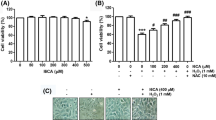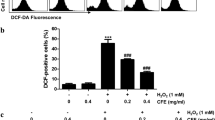Abstract
Background
Oxidative stress-induced myoblast damage is one of the major causes of skeletal muscle loss associated with inhibition of myogenic differentiation and muscle dysfunction. Trans-cinnamaldehyde (tCA), the most common essential oil constituent in cinnamon, is known to possess strong anti-oxidant activity. However, it has not been determined whether tCA can protect myoblasts from oxidative damage.
Objectives
The aim of this study was to investigate the protective effect of tCA against oxidative stress-induced damage in mouse myoblast C2C12 cells.
Methods
To examine the efficacy of tCA to protect against oxidative damage, cell viability, morphological changes, DNA damage, mitochondrial membrane potential (MMP) analysis, reactive oxygen species (ROS) generation, and Western blotting were applied.
Results
tCA suppressed hydrogen peroxide (H2O2)-induced growth inhibition and DNA damage by blocking abnormal ROS accumulation. In addition, tCA attenuated apoptosis by suppressing loss of MMP and cytosolic release of cytochrome c, increasing the rate of Bcl-2/Bax expression and reducing the activity of caspase-3 in H2O2-stimulated cells, suggesting that tCA protected C2C12 cells from mitochondria-mediated apoptosis caused by oxidative stress.
Conclusion
The results showed that tCA may be useful as a potential treatment for the prevention and treatment of various oxidative stress-related muscle disorders in the future.







Similar content being viewed by others
References
Abou El-Ezz D, Maher A, Sallam N, El-Brairy A, Kenawy S (2018) Trans-cinnamaldehyde modulates hippocampal Nrf2 factor and inhibits amyloid beta aggregation in LPS-induced neuroinflammation mouse model. Neurochem Res 43:2333–2342
Ahn CH, Lee WW, Jung YC, Shin JA, Hong KO, Choi S, Swarup N, Kim J, Ahn MH, Jung M, Cho SD, Jin B (2019) Antitumor effect of TW-37, a BH3 mimetic in human oral cancer. Lab Anim Res 35:27
Aristizabal-Pachon AF, Castillo WO (2019) Genotoxic evaluation of occupational exposure to antineoplastic drugs. Toxicol Res 36:29–36
Berger ND, Stanley FKT, Moore S, Goodarzi AA (2017) ATM-dependent pathways of chromatin remodelling and oxidative DNA damage responses. Philos Trans R Soc Lond B Biol Sci 372:20160283
Bock FJ, Tait SWG (2020) Mitochondria as multifaceted regulators of cell death. Nat Rev Mol Cell Biol 21:85–100
Caporossi D, Ciafrè SA, Pittaluga M, Savini I, Farace MG (2003) Cellular responses to H2O2 and bleomycin-induced oxidative stress in L6C5 rat myoblasts. Free Radic Biol Med 35:1355–1364
Chang NC, Rudnicki MA (2014) Satellite cells: the architects of skeletal muscle. Curr Top Dev Biol 107:161–181
Chew EH, Nagle AA, Zhang Y, Scarmagnani S, Palaniappan P, Bradshaw TD, Holmgren A, Westwell AD (2010) Cinnamaldehydes inhibit thioredoxin reductase and induce Nrf2: potential candidates for cancer therapy and chemoprevention. Free Radic Biol Med 48:98–111
Chiang YF, Chen HY, Huang KC, Lin PH, Hsia SM (2019) Dietary antioxidant trans-cinnamaldehyde reduced visfatin-induced breast cancer progression: in vivo and in vitro study. Antioxidants (Basel) 8:E625
Choi YH (2018) Schisandrin A prevents oxidative stress-induced DNA damage and apoptosis by attenuating ROS generation in C2C12 cells. Biomed Pharmacother 106:902–909
Davaatseren M, Jo YJ, Hong GP, Hur HJ, Park S, Choi MJ (2017) Studies on the anti-oxidative function of trans-cinnamaldehyde-included β-cyclodextrin complex. Molecules 22:E1868
del Río LA, Sandalio LM, Corpas FJ, Palma JM, Barroso JB (2006) Reactive oxygen species and reactive nitrogen species in peroxisomes. Production, scavenging, and role in cell signaling. Plant Physiol 141:330–335
Di Filippo ES, Mancinelli R, Pietrangelo T, La Rovere RM, Quattrocelli M, Sampaolesi M, Fulle S (2016) Myomir dysregulation and reactive oxygen species in aged human satellite cells. Biochem Biophys Res Commun 473:462–470
Er E, Oliver L, Cartron PF, Juin P, Manon S, Vallette FM (2006) Mitochondria as the target of the pro-apoptotic protein Bax. Biochim Biophys Acta 1757:1301–1311
Fulle S, Sancilio S, Mancinelli R, Gatta V, Di Pietro R (2013) Dual role of the caspase enzymes in satellite cells from aged and young subjects. Cell Death Dis 4:e955
Gannon NP, Schnuck JK, Mermier CM, Conn CA, Vaughan RA (2015) trans-Cinnamaldehyde stimulates mitochondrial biogenesis through PGC-1α and PPARβ/δ leading to enhanced GLUT4 expression. Biochimie 119:45–51
Hansen JM, Klass M, Harris C, Csete M (2007) A reducing redox environment promotes C2C12 myogenesis: implications for regeneration in aged muscle. Cell Biol Int 31:546–553
Hassan M, Watari H, AbuAlmaaty A, Ohba Y, Sakuragi N (2014) Apoptosis and molecular targeting therapy in cancer. Biomed Res Int 2014:150845
Ji LL (2015) Redox signaling in skeletal muscle: role of aging and exercise. Adv Physiol Educ 39:352–359
Johnson ML, Robinson MM, Nair KS (2013) Skeletal muscle aging and the mitochondrion. Trends Endocrinol Metab 24:247–256
Kiraz Y, Adan A, KartalYandim M, Baran Y (2016) Major apoptotic mechanisms and genes involved in apoptosis. Tumour Biol 37:8471–8486
Kopp B, Khoury L, Audebert M (2019) Validation of the γH2AX biomarker for genotoxicity assessment: a review. Arch Toxicol 93:2103–2114
Kuchařová M, Hronek M, Rybáková K, Zadák Z, Štětina R, Josková V, Patková A (2019) Comet assay and its use for evaluating oxidative DNA damage in some pathological states. Physiol Res 68:1–15
Lee YH, Kim WJ, Lee MH, Kim SY, Seo DH, Kim HS, Gelinsky M, Kim TJ (2016) Anti-skeletal muscle atrophy effect of Oenothera odorata root extract via reactive oxygen species-dependent signaling pathways in cellular and mouse model. Biosci Biotechnol Biochem 80:80–88
Park C, Choi SH, Jeong JW, Han MH, Lee H, Hong SH, Kim GY, Moon SK, Kim WJ, Choi YH (2019) Honokiol ameliorates oxidative stress-induced DNA damage and apoptosis of c2c12 myoblasts by ROS generation and mitochondrial pathway. Anim Cells Syst (Seoul) 24:60–68
Popgeorgiev N, Jabbour L, Gillet G (2018) Subcellular localization and dynamics of the Bcl-2 family of proteins. Front Cell Dev Biol 6:13
Rogiers G, Kebede BT, Van Loey A, Michiels CW (2015) Membrane fatty acid composition as a determinant of Listeria monocytogenes sensitivity to trans-cinnamaldehyde. Res Microbiol 168:536–546
Sambasivan R, Tajbakhsh S (2015) Adult skeletal muscle stem cells. Results Probl Cell Differ 56:191–213
Sandiford SD, Kennedy KA, Xie X, Pickering JG, Li SS (2014) Dual oxidase maturation factor 1 (DUOXA1) overexpression increases reactive oxygen species production and inhibits murine muscle satellite cell differentiation. Cell Commun Signal 12:5
Santa-Gonzalez GA, Gomez-Molina A, Arcos-Burgos M, Meyer JN, Camargo M (2016) Distinctive adaptive response to repeated exposure to hydrogen peroxide associated with upregulation of DNA repair genes and cell cycle arrest. Redox Biol 9:124–133
Santos HO, da Silva GAR (2018) To what extent does cinnamon administration improve the glycemic and lipid profiles? Clin Nutr ESPEN 27:1–9
Wong HS, Benoit B, Brand MD (2019) Mitochondrial and cytosolic sources of hydrogen peroxide in resting C2C12 myoblasts. Free Radic Biol Med 130:140–150
Xia T, Gao R, Zhou G, Liu J, Li J, Shen J (2019) Trans-cinnamaldehyde inhibits IL-1β-stimulated inflammation in chondrocytes by suppressing NF-κB and p38-JNK pathways and exerts chondrocyte protective effects in a rat model of osteoarthritis. Biomed Res Int 2019:4039472
Xiong S, Mu T, Wang G, Jiang X (2014) Mitochondria-mediated apoptosis in mammals. Protein Cell 5:737–749
Zhang JH, Liu LQ, He YL, Kong WJ, Huang SA (2010) Cytotoxic effect of trans-cinnamaldehyde on human leukemia K562 cells. Acta Pharmacol Sin 31:861–866
Zhang C, Fan L, Fan S, Wang J, Luo T, Tang Y, Chen Z, Yu L (2019) Cinnamomum cassia Presl: a review of its traditional uses, phytochemistry, pharmacology and toxicology. Molecules 24:E3473
Funding
Not applicable.
Author information
Authors and Affiliations
Contributions
YHY designed experiments, conducted the experiments, interpreted the results, wrote and finalized the manuscript.
Corresponding author
Ethics declarations
Conflict of interest
The author declares no conflicts of interest.
Additional information
Publisher's Note
Springer Nature remains neutral with regard to jurisdictional claims in published maps and institutional affiliations.
Rights and permissions
About this article
Cite this article
Choi, Y.H. Trans-cinnamaldehyde protects C2C12 myoblasts from DNA damage, mitochondrial dysfunction and apoptosis caused by oxidative stress through inhibiting ROS production. Genes Genom 43, 303–312 (2021). https://doi.org/10.1007/s13258-020-00987-9
Received:
Accepted:
Published:
Issue Date:
DOI: https://doi.org/10.1007/s13258-020-00987-9




